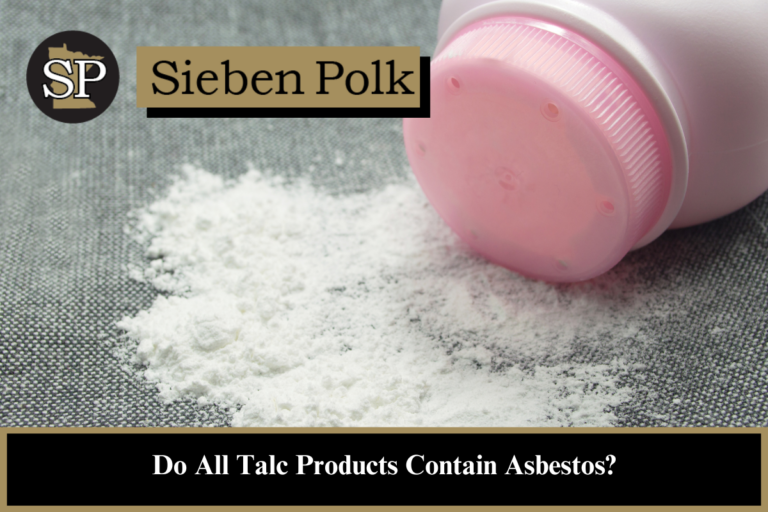Before it became the center of legal controversy, talcum powder was a staple in every bathroom and on every diaper-changing table. For over 100 years, Johnson & Johnson Baby Powder was a household name and on every new mother’s baby registry.
It wasn’t always commonly known that talc could contain asbestos, but now—years after that discovery—talc-related asbestos exposures are still common. Not all talc products contain asbestos, but any amount is unacceptable. If you think you’ve been a victim of asbestos exposure through talc-based products, the Minnesota asbestos lawyers at Sieben Polk P.A. can help guide you through the legal compensation process in Minnesota.
Does All Talc Contain Asbestos?
Not all talc contains asbestos, but many carry the risk of asbestos exposure. The problem isn’t with the talcum powder itself but with where the mineral is mined.
Talc and Asbestos
Common Talc Products Known To Contain Asbestos
Despite widespread knowledge that talc can contain asbestos, the mineral is still used extensively in product manufacturing. Chances are that most American households have talc products under their roof without realizing it.
Johnson & Johnson Baby Powder
According to a Reuters investigative report, Johnson & Johnson knew for decades that their talcum baby powder product was intermittently contaminated with asbestos. Not every batch was contaminated, but many were.
Reuters found Johnson & Johnson records and test results showing that their talc sometimes tested positive for asbestos. One test record reports asbestos levels as “rather high” in that batch.
Only a very small number of talc batches are ever tested, so it’s likely that a great many contaminated batches of Johnson & Johnson Baby Powder went out undetected. Many women and women of color sued Johnson & Johnson for marketing their product toward them while knowing it could contain a carcinogen.
The company also influenced the government’s plan to limit the amount of asbestos that could legally be in a cosmetic talc product. They successfully overturned the regulators and barred scientific research that would reveal the health impact of talc products.
Is Talcum Powder Still Safe to Use?
The problem with talcum powder is the talc is contaminated at the source. It wasn’t a Johnson & Johnson-specific issue. All talcum has the potential to be contaminated by asbestos because both minerals are naturally occurring in the same area.
You can’t know whether a bottle of talcum powder is contaminated, so it’s safest to avoid using it.
Cosmetics and Makeup
Unfortunately, talc is widely used in the cosmetics, toiletry, and fragrance industries. Even though it’s known that talc is a common vehicle for asbestos exposure, a great many brands still use it as a base for eyeshadows, blushes, highlighters, and other powdered or pressed products.
In 2020, the advocacy organization Environmental Working Group analyzed 21 talc-containing makeup products and found that 15 percent of the samples contained asbestos.
The following three asbestos-containing products were marketed to children:
- Claire’s Pink Glitter Palette With Eyeshadow and Lip Gloss
- Jojo Siwa Makeup Set
- Justice Just Shine Shimmer Powder
As of 2023, there have been over 14,000 lawsuits against companies that make talc cosmetics products, alleging that those products caused ovarian cancer or mesothelioma.
It’s recommended that you only buy makeup from brands that publish their ingredients so you can verify that it’s free of talc.
Industrial and Household Talc Products
Talc appears in a wide variety of industrial and household products, including:
- Anticaking agents
- Ceramics
- Crayons
- Chalk
- Paper
- Ink
- Plastics
- Rubbers
- Automotive parts
These are only a few of the products containing talc. People come into contact with many of these items regularly, even daily. You don’t even have to come directly into contact with the talc-containing products to be exposed because asbestos particles become airborne upon handling.
Can I Get Compensation for Talc-Related Asbestos Exposure?
There are two main ways to get compensation for talc-related asbestos injury: lawsuit verdicts and out-of-court settlements. Talking to a qualified asbestos injury lawyer can help you determine which route to go and walk you through the process.
Filing lawsuits for asbestosis and other asbestos-related injuries can be time-sensitive. To build as strong a case as possible, we encourage you to contact us as soon as possible to learn more. Call us with any questions you may have at 651-437-3148.
Contact Sieben Polk LawFirm today for a free initial consultation. You don’t pay us unless we obtain compensation for your claim.
